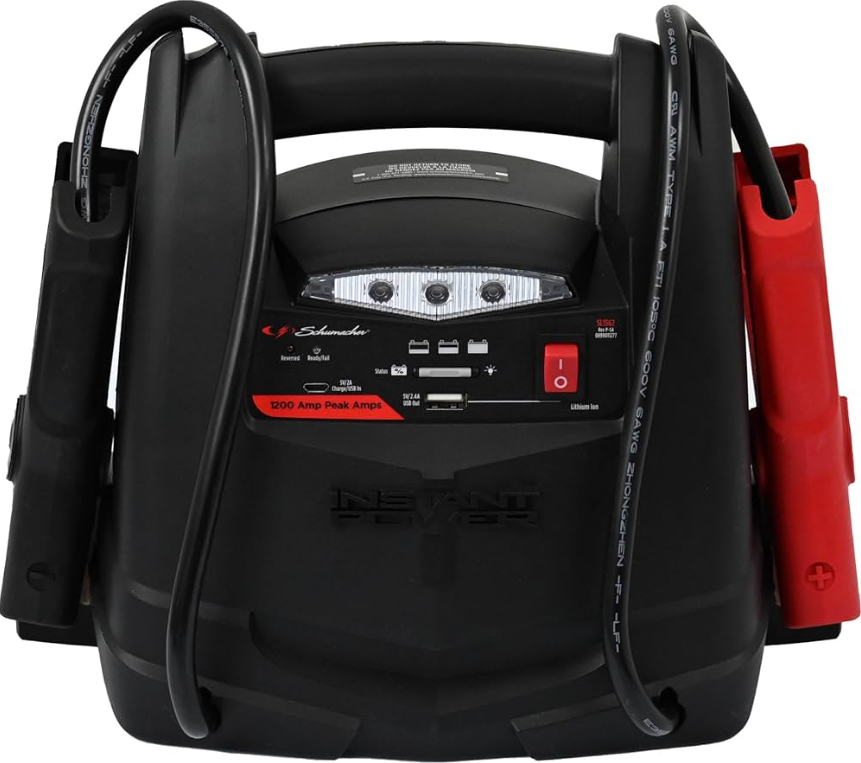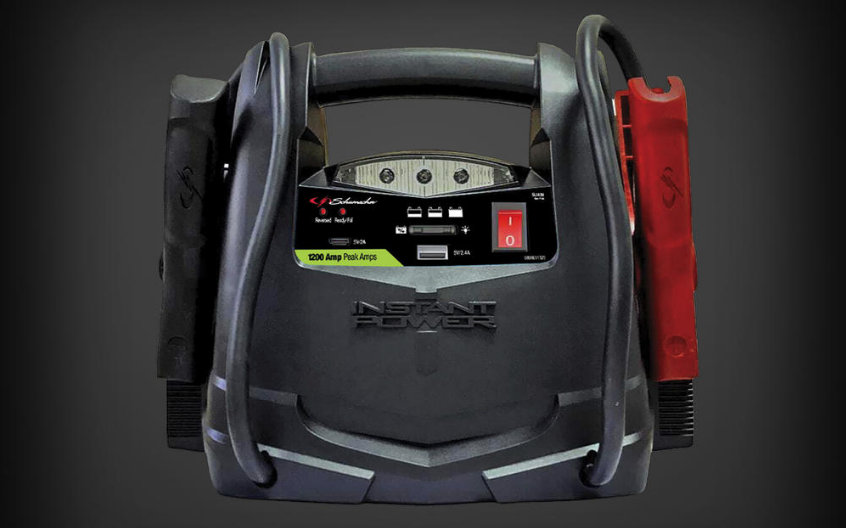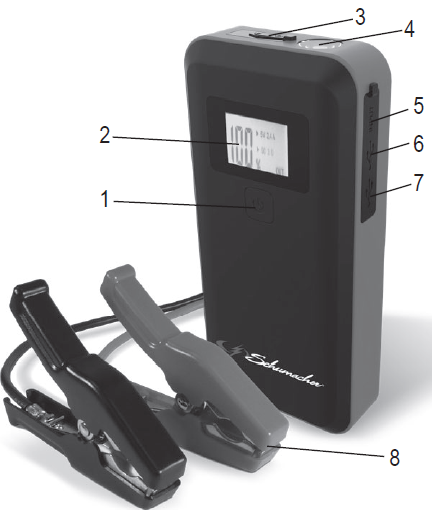
Schumacher SL582 1200A Jump Starter

IMPORTANT SAFETY INSTRUCTIONS
SAVE THESE INSTRUCTIONS.
WARNING – RISK OF EXPLOSIVE GASES.
WORKING IN THE VICINITY OF A LEAD-ACID BATTERY IS DANGEROUS. BATTERIES GENERATE EXPLOSIVE GASES DURING NORMAL OPERATION. IT IS IMPORTANT THAT YOU FOLLOW THESE INSTRUCTIONS EACH TIME YOU USE THE UNIT.
To reduce the risk of battery explosion, follow these instructions and those published by the battery manufacturer and the manufacturer of any equipment you intend to use in the vicinity of a battery. Review cautionary markings on these products and on the engine.
WARNING! RISK OF ELECTRIC SHOCK OR FIRE.
- Read the entire manual before using this product. Failure to do so could result in serious injury or death.
- Keep out of reach of children.
- Do not expose the unit to rain or snow.
- Use only recommended attachments (SA934 jump cable). Use of an attachment not recommended or sold by the jump starter manufacturer for the unit may result in a risk of fire, electric shock, or injury to persons or damage to property.
- To reduce the risk of damage to the electric plug or cord, pull by the adaptor rather than the cord when disconnecting the unit.
- Do not operate the unit with damaged cables or clamps.
- Do not operate the unit if it has received a sharp blow, been dropped, or otherwise damaged in any way; take it to a qualified service person.
- Do not disassemble the unit; take it to a qualified service person when service or repair is required. Incorrect reassembly may result in a risk of fire or electric shock.
WARNING! RISK OF EXPLOSIVE GASES.
- To reduce the risk of a battery explosion, follow these instructions and those published by the battery manufacturer and the manufacturer of any equipment you intend to use in the vicinity of the battery. Review the cautionary markings on these products and on the engine.
- Do not set the unit on flammable materials, such as carpeting, upholstery, paper, cardboard, etc.
- Never place the unit directly above the battery being jumped.
- Do not use the unit to jump-start a vehicle while charging the internal battery.
Personal Precautions
WARNING! RISK OF EXPLOSIVE GASES. A SPARK NEAR THE BATTERY MAY CAUSE A BATTERY EXPLOSION. TO REDUCE THE RISK OF A SPARK NEAR THE BATTERY:
- NEVER smoke or allow a spark or flame in the vicinity of a battery or engine.
- Remove personal metal items such as rings, bracelets, necklaces, and watches when working with a lead-acid battery. A lead-acid battery can produce a short-circuit current high enough to weld a ring to metal, causing a severe burn.
- Be extra cautious to reduce the risk of dropping a metal tool onto the battery. It might spark or short-circuit the battery or other electrical parts, which may cause an explosion.
- Do not permit the internal battery of the unit to freeze. Never charge a frozen battery.
- To prevent sparking, NEVER allow clamps to touch together or contact the same piece of metal.
- Consider having someone nearby to come to your aid when you work near a lead-acid battery.
- Have plenty of fresh water, soap, and baking soda nearby for use, in case battery acid contacts your eyes, skin, or clothing.
- Wear complete eye and body protection, including safety goggles and protective clothing. Avoid touching your eyes while working near the battery.
- If battery acid contacts your skin or clothing, immediately wash the area with soap and water. If acid enters your eye, immediately flood the eye with cold running water for at least 10 minutes and get medical attention right away.
- Neutralize any acid spills thoroughly with baking soda before attempting to clean up.
WARNING! RISK OF CONTACT WITH BATTERY ACID. BATTERY ACID IS A HIGHLY CORROSIVE SULFURIC ACID.
- Make sure the area around the battery is well ventilated while the unit is in use.
- Clean the battery terminals before using the jump starter. During cleaning, keep airborne corrosion from coming into contact with your eyes, nose, and mouth. Use baking soda and water to neutralize the battery acid and help eliminate airborne corrosion. Do not touch your eyes, nose, or mouth.
- Determine the voltage of the battery by referring to the vehicle owner’s manual, and make sure that the output voltage is 12V.
- Make sure that the unit’s cable clamps make tight connections.
WARNING! A SPARK NEAR THE BATTERY MAY CAUSE A BATTERY EXPLOSION. TO REDUCE THE RISK OF A SPARK NEAR THE BATTERY:
- Plug the clamps into the unit, and then attach the output cables to the battery and chassis as indicated below. Never allow the output clamps to touch each other.
- Position the DC cables to reduce the risk of damage from the hood, door, and moving or hot engine parts. NOTE: If it is necessary to close the hood during the jump-starting process, ensure that the hood does not touch the metal part of the battery clips or cut the insulation of the cables.
- For a negative-grounded vehicle, connect the POSITIVE (RED) clamp from the jump starter to the POSITIVE (POS, P, +) ungrounded post of the battery. Connect the NEGATIVE (BLACK) clamp to the vehicle chassis or engine block away from the battery. Do not connect the clamp to the carburetor, fuel lines, or sheet-metal body parts. Connect to a heavy-gauge metal part of the frame or engine block.
- For a positive-grounded vehicle, connect the NEGATIVE (BLACK) clamp from the jump starter to the NEGATIVE (NEG, N, -) ungrounded post of the battery. Connect the POSITIVE (RED) clamp to the vehicle chassis or engine block away from the battery. Do not connect the clamp to the carburetor, fuel lines, or sheet-metal body parts. Connect to a heavy-gauge metal part of the frame or engine block.
- When finished using the jump starter, remove the clamp from the vehicle chassis and then remove the clamp from the battery terminal. Disconnect the clamps from the unit.
FEATURES
- Display button
- LCD display
- Jump-start the output socket
- LED light
- USB input port for recharging
- 2.4A USB output port
- 3A USB output port
- Battery clamps/smart cable
- USB charging cable
- Carrying bag
CHARGING THE JUMP STARTER
IMPORTANT! CHARGE IMMEDIATELY AFTER PURCHASE, AFTER EACH USE AND EVERY 30 DAYS, OR WHEN THE CHARGE LEVEL FALLS BELOW 85%, TO KEEP THE INTERNAL BATTERY FULLY CHARGED AND PROLONG BATTERY LIFE.
CHECKING THE LEVEL OF THE INTERNAL BATTERY
- Press the display button. The LCD display will show the battery’s percentage of charge. A fully charged internal battery will read 100%. Charge the internal battery if the display shows it is under 85%.
- To reduce the risk of electric shock, unplug the unit’s charging cable from a USB or wall charger before attempting any maintenance or cleaning. Simply turning off the controls will not reduce this risk.
- When charging the internal battery, work in a well-ventilated area and do not restrict the ventilation in any way.
CHARGING THE INTERNAL BATTERY
Use a 2A USB charger (not included) to quickly recharge the jump starter.
- Plug the USB end of the charging cable into the charger port. Next, plug the USB end of the charging cable into a charger’s USB port.
- Plug your charger into a live AC or DC power outlet.
- The LCD display will light, the digit begins to flash, and show ‘IN’, indicating that charging has begun.
- The jump starter will fully charge in 4-5 hours. When the unit is fully charged, the display will show “100%”.
- When the battery is fully charged, disconnect your charger from the outlet, and then remove the charging cable from the charger and the unit.
OPERATING INSTRUCTIONS
JUMP STARTING A VEHICLE ENGINE
NOTE: Use only the model number SA934 jump cable.
IMPORTANT: Do not use the jump starter while charging its internal battery.
IMPORTANT: Using the jump starter without a battery installed in the vehicle will damage the vehicle’s electrical system.
NOTE: The internal battery must have a charge of at least 40% to Jump-start a vehicle.
- Turn the ignition OFF.
- Plug the battery clamp cable into the jump starter’s output socket.
- Lay the DC cables away from any fan blades, belts, pulleys, and other moving parts. Make sure all of the vehicle’s electrical devices are turned off.
- For a negative-grounded vehicle, connect the POSITIVE (RED) clamp from the jump starter to the POSITIVE (POS, P, +) ungrounded post of the battery. Connect the NEGATIVE (BLACK) clamp to the vehicle chassis or engine block away from the battery. Do not connect the clamp to the carburetor, fuel lines, or sheet-metal body parts. Connect to a heavy-gauge metal part of the frame or engine block.
- For a positive-grounded vehicle, connect the NEGATIVE (BLACK) clamp from the jump starter to the NEGATIVE (NEG, N, -) ungrounded post of the battery. Connect the POSITIVE (RED) clamp to the vehicle chassis or engine block away from the battery. Do not connect the clamp to the carburetor, fuel lines, or sheet-metal body parts. Connect to a heavy-gauge metal part of the frame or engine block.
- The green LED on the smart cable should light up. NOTE: If the vehicle battery is extremely discharged, the initial current draw from the jump starter may activate short-circuit protection in the smart cable. When the condition is corrected, the smart cable will automatically reset.
- After a proper connection has been made, crank the engine. If the engine does not start within 5-8 seconds, stop cranking and wait at least 1 minute before attempting to start the vehicle again. NOTE: If the car does not crank a second time, check the smart cable to see if the green LED is lit. If you hear beeping or an LED is flashing, refer to section 10, Troubleshooting. When the condition is corrected, the smart cable will automatically reset. Cold weather may affect the performance of the jump starter’s lithium battery. If you hear only a click and the engine does not turn over, try the following: With the jump starter connected to the car battery and the green LED illuminated on the smart cable, turn on all lights and electrical accessories for one minute. This draws current from the jump starter and warms the battery. Now, try to crank the engine. If it does not turn over, repeat the procedure. Extremely cold weather may require two or three battery warmings before the engine will start. If no activity is detected, the smart cable will automatically shut off after 90 seconds, and the red and green LEDs will be solid. To reset, disconnect the clamps from the vehicle battery, and then reconnect. IMPORTANT: DO NOT attempt to jump-start your vehicle more than three consecutive times. If the vehicle will not start after three attempts, consult a service technician.
- After the engine starts, unplug the battery clamps from the jump starter socket and then disconnect the black clamp (-) and the red clamp (+), in that order.
- Recharge the unit as soon as possible after each use.
CHARGING A MOBILE DEVICE, USING THE USB PORTS
The unit includes two USB ports. One provides up to 2.4A at 5V DC; the other is a USB Fast Charging port, which provides up to 5V at 3A, 9V at 2A, or 12V at 1.5A.
- Consult your mobile device manufacturer for proper charging power specifications. Connect a mobile device cable to the appropriate USB port.
- Charging should begin automatically. The display will show which port is in use.
- Charging time will vary based on the mobile device’s battery size and the charging port used. NOTE: Most devices will charge with either USB port, but may charge at a slower rate.
- When finished using the USB port, disconnect the charging cable from your mobile device and then disconnect the charging cable from the unit.
- Recharge the unit as soon as possible after each use.
NOTE: If no USB device is connected, power to the USB ports will automatically shut off after 30 seconds.
USING THE LED LIGHT
- Hold down the display power button for 2 seconds.
- Once the LED light is on, press and release the display power button to cycle through the following modes:
- Steady glow
- Flash for an SOS signal
- Flash in strobe mode
- When finished using the LED light, press and hold the display power button until the light turns off.
- Recharge the unit as soon as possible after each use.
MAINTENANCE INSTRUCTIONS
- After use and before performing maintenance, unplug and disconnect the unit.
- Use a dry cloth to wipe all battery corrosion and other dirt or oil from the battery clamps, cords, and the outer case.
- Do not open the unit, as there are no user-serviceable parts.
TROUBLESHOOTING
Jump Starter
The jump starter’s display will not turn on.
Make sure the unit is charged.
Connect to a power source to reset.
The thermometer symbol is flashing.
The unit is too hot or too cold. The thermometer symbol will disappear when the condition is removed.
The jump starter will not recharge.
Make sure the power source is live.
The jump starter turns on, but won’t jump-start my vehicle.
Check connections.
Verify that the charge level of the jump starter is at least 40%.
Do not attempt to jump-start your vehicle more than three consecutive times. If the vehicle still does not start, consult a qualified service technician.
When the cable is correctly connected to both battery and jump starter, the Green LED is blinking; the Red LED is off: no beep.
“Fake” high battery voltage is detected, but reverse charging protection did not activate. The user can turn the key to jump-start the vehicle.
Smart Cable LED and Alarm Behavior
Green Ready LED blinking; Red Fault and Clamp Reverse LEDs off: no beep.
The cable is connected to the jump starter only.
Green Ready LED solid; Red Fault and Clamp Reverse LEDs off, no beep.
The cable is connected correctly to both the battery and the jump starter.
Red Fault and Clamp Reverse LEDs solid, Green Ready LED off, rapid beeping
Reverse polarity protection
No LED illuminated; no beep
The battery is exhausted, or poor connection
Red Fault LED solid, Green Ready, and Red Reverse Clamp LEDs off; rapid beeping.
Short circuit protection
Red Fault and Green Ready LEDs solid; Red Clamp Reverse LED off, beeps once per second
Temperature protection
NOTE: When the condition is corrected, the smart cable will automatically reset.
BEFORE RETURNING FOR REPAIRS
For REPAIRS OR RETURNS, visit 365rma.com
Visit schumacherelectric.com for Replacement Parts.
For more Manuals by Schumacher, visit ManualsLibraryy
Schumacher SL582 1200A Jump Starter-FAQs
Can I use the SL582 in cold weather?
Yes, but extreme cold may reduce performance—store it indoors when not in use.
How long does a jump starter last?
3–5 years with proper care (recharge every 3–6 months if unused).
Can the SL582 charge phones or devices?
No, this model is only for jump-starting (no USB ports).
What’s the difference between peak amps and cranking amps?
Peak amps (1200A): Max power for a quick burst.
Cranking amps (400A): Sustained power to start the engine.
Why won’t my car start even after a jump?
Possible alternator failure, bad battery, or starter issues—get a professional inspection.
How do I store the jump starter safely?
Keep in a cool, dry place.
Recharge every 3 months to maintain battery health.
Can I leave the jump starter plugged in overnight?
Yes, but unnecessary—it stops charging automatically at 100% (prevents overcharging).
How do I check the battery level?
The LED display shows the charge percentage (e.g., 80% = ready for use).
Can the SL582 jump-start a completely dead battery?
Yes, but it won’t recharge a dead battery—just provides enough power to start the engine.
How many amps does the SL582 provide?
1200 peak amps (enough for most cars, trucks, and SUVs).


